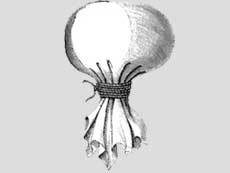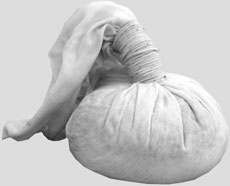An Appreciation of the Pudding Cloth.
 Steamed or boiled puddings originated in England and, if they have become more novelty than staple, represent one of the most archetypal of British foods--as they have been since their inception. Like most foods, puddings have evolved from their original form and have mutated into many variations. For reasons that nobody appears to have explored, however, puddings never spread outside of Britain and its imperial outposts. They proliferated in eighteenth and nineteenth century North America but have nearly disappeared from the United States altogether.
Steamed or boiled puddings originated in England and, if they have become more novelty than staple, represent one of the most archetypal of British foods--as they have been since their inception. Like most foods, puddings have evolved from their original form and have mutated into many variations. For reasons that nobody appears to have explored, however, puddings never spread outside of Britain and its imperial outposts. They proliferated in eighteenth and nineteenth century North America but have nearly disappeared from the United States altogether.
Most scholars who have addressed the subject date the ‘invention’ of the pudding cloth to the early seventeenth century, although as noted in the critical, William Carew Hazlitt apparently dissents by placing its origins in the realm of Arthurian legend. We have found no source for his assertion and without conducting our own original research therefore accept Kate Colquohon’s statement that the “earliest written record of a pudding boiled in a cloth comes from Cambridge in 1617” unless our readers give us reason to conclude otherwise. (Colquohon 123)
It is no exaggeration to claim that the use of a plain kitchen towel for cooking revolutionized English and then British foodways. Colquohon asserts that Elizabeth I, who died in 1603,
“probably did not live to see the greatest culinary discovery, first recorded in the seventeenth century [Colquohon is to be forgiven for the redundancy]: the simple finding that a piece of sturdy cloth, dipped in water as hot as one’s hands could bear and then well floured, could be tied up around a suety or batter mix--savoury or sweet--and boiled without the contents leaching out as they swelled.” (Colquohon 122)
Before the discovery of the pudding cloth, the preparation of puddings was constrained by the shortage of containers, either stomach or large intestine; if an animal was not slaughtered, then it was not possible to cook a pudding. Once cloth came into play, however, puddings became the welcome weeds of the British culinary landscape, and contributed in no small way to the development of a distinctive national cuisine.
Both the variety and production of puddings proliferated. Foreign travelers in England as early as the seventeenth century remarked on the many kinds of puddings they encountered: by 1698,
“[t]he pudding, as Henri Misson pointed out (in a remark so often quoted in its relentlessly quaint English translation of 1719 that many modern commentators have missed its irony), was a many-splendoured thing, varying greatly in its ingredients and in the way it was cooked.” (Lehmann 198)
As an aside, it would appear that commentators have not so much missed the irony as interpreted this comment in a different way. Colquohon for one concludes that although Misson found English food “broadly distasteful,” he
“found in puddings a relief almost beyond words, and from the moment of its invention, it quickly became so much a part of English life that it would continue to develop over the next three hundred years.” (Colquohon 123)
The reaction of other travelers supports Colquohon’s interpretation. In 1726, for example, Muralt found that, in England, “everyone is accustomed to good eating.” The good food he encountered included “a variety of puddings” along with “excellent” apples, “delicious green oysters and roast beef.” (Muralt 39-40)
 It would be difficult to overstate the importance of puddings in the diet of eighteenth century Britain or the esteem in which the British held them. Puddings proliferated in kitchen manuscripts as well as printed books. Samuel Johnson adored them, both at table and in print. William Ellis wrote in 1750 that “[p]udding is so natural to our Harvest men that without it they think they cannot make an agreeable dinner.” (Ellis 51) According to Misson, “[g]ive an English man a pudding and he shall think it a noble treat in any part of the world.” (Oxford Companion 638) It was nutritious, cheap and “crossed the social divides.” (Colquohon 124; see Rogers 14, citing Muralt)
It would be difficult to overstate the importance of puddings in the diet of eighteenth century Britain or the esteem in which the British held them. Puddings proliferated in kitchen manuscripts as well as printed books. Samuel Johnson adored them, both at table and in print. William Ellis wrote in 1750 that “[p]udding is so natural to our Harvest men that without it they think they cannot make an agreeable dinner.” (Ellis 51) According to Misson, “[g]ive an English man a pudding and he shall think it a noble treat in any part of the world.” (Oxford Companion 638) It was nutritious, cheap and “crossed the social divides.” (Colquohon 124; see Rogers 14, citing Muralt)
According to Laura Mason, something that “came in pudding time” was something that was well timed. (Rogers 25, 25n.13) She apparently refers to our acquaintance Misson, who wrote that “[t]o come in pudding time, is as much as to say, is to come in the most lucky moment in the world.” (Companion 638)
By 1855, Eliza Acton would include some hundred variations on the theme and an entire chapter on boiled puddings. She leaves no doubt about her enthusiasm for the dish:
“The perfect manner in which the nutriment and flavour of an infinite variety of viands may be preserved by enclosing and boiling them in paste, is a great recommendation to this purely English class of dishes, the advantages of which foreign cooks are beginning to acknowledge. If really well made, these savoury puddings are worthy of a place on any table; although the decrees of fashion--which have in many instances have so much more influence with us than they deserve--have hitherto confined them almost entirely to the simple family dinners of the middle classes....” (Acton 336) (emphasis in original)
As Mrs. Acton indicates, by mid-century the pudding had begun its descent from universal apotheosis; still, a few years later in 1861, the first edition of Mrs. Beeton would include more than one hundred versions.
What were the early puddings like? They were much like the ones that Mrs. Acton and Mrs. Beeton recorded. Back in the eighteenth century Misson found the English pudding “a thing very difficult to describe,” not for its complication or obscurity but for its versatility; “they make them fifty several ways.” (Misson 315) He explained that a great range of ingredients, including barley, bone marrow, bread, butter, carrots, dried peas, flour, meat and oatmeal variously found their way into puddings. (Rogers 26) He could have listed more.
None of this would have been possible without the cloth. It was important for a cook to have the skills required to cook pudding, so Mrs. Glasse, who published over five dozen recipes (in 1747), offers detailed instruction under the heading “Rules to be observed in making Puddings &c.:”
“In boiled Puddings, take great Care the Bag or Cloth be very clean, and not soapy, and dipped in hot water, and then well flowered. If a Bread-pudding, tye it loose; if a Batter pudding, tye it close; and be sure the Water boils when you put the Pudding in, and you should move your Puddings in the Pot now and then, for fear they stick.” (Glasse 70)
The dominance of the pudding cloth began to recede following the adoption of the ceramic basin, which, oddly, Alan Davidson does not date until the dearth of skilled servants in the twentieth century (Oxford Companion 638); Mrs. Acton includes a spirited discussion of proper techniques for use with both pudding basins and molds as early as 1855. For some puddings, however, she finds the old-style rolled cloth superior, and perhaps Davidson meant to comment on its gradual replacement with the basin, which may or may not be easier to use but which indisputably provokes less anxiety in beginners. Davidson is not clear on the point.
In any event, people including the Editor still follow recipes calling for the use of a cloth, and we agree with Mrs. Acton (as usual) that the character of the two variations is different. Live a little history and try using a pudding cloth. It is easy and fun. bfia will return to the subject of cloth puddings; meanwhile, one example of a simple savory pudding for cooking in cloth appears in the practical.
Sources.
-Eliza Acton, Modern Cookery for Private Families (London 1855)
-Isabella Beeton, The Book of Household Management (London 1861)
-Kate Colquohon, Taste (New York 2007)
-Alan Davidson, The Oxford Companion to Food (Oxford 1999)
-William Ellis, The Country Housewife’s Family Companion (London 1750)
-Hannah Glasse, The Art of Cookery Made Plain and Easy (London 1747; Prospect books facsimile 1995)
-Henri Misson, Memoirs and Observations of Travels Over England (London 1719)
-M. Muralt, Letters Describing the Character and Customs of the English and French Nations (London 1726)
-Ben Rogers, Beef and Liberty (London 2004)

